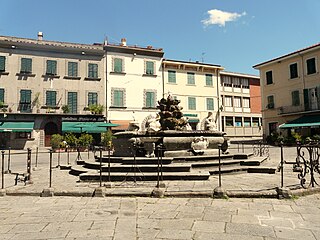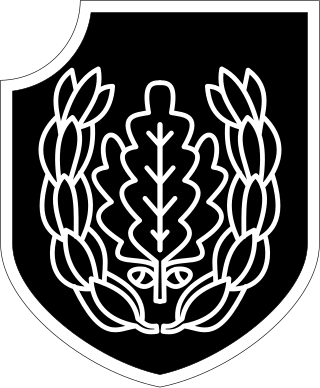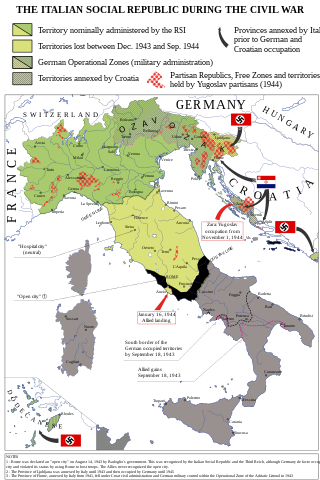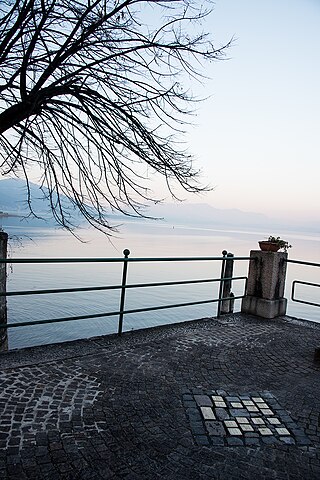
The Marzabotto massacre, or more correctly, the massacre of Monte Sole, was a World War II war crime consisting of the mass murder of at least 770 civilians by Nazi troops, which took place in the territory around the small village of Marzabotto, in the mountainous area south of Bologna. It was the largest massacre of civilians committed by the Waffen SS in western Europe during the war. It is also the deadliest mass shooting in the history of Italy.

Fivizzano is a comune in the province of Massa and Carrara, Tuscany, central Italy.

Walter Reder was an Austrian SS commander and war criminal during World War II. He served with the SS Division Totenkopf and the SS Division Reichsführer-SS. He and the unit under his command committed the Vinca massacre and Marzabotto massacre in Italy in 1944. After the war, Reder was convicted of war crimes in Italy.
The Boves massacre was a World War II war crime that took place on 19 September 1943 in the comune of Boves, Italy. The event took place following the Italian surrender on 8 September 1943. Twenty-three Italian civilians were killed and several hundred houses were destroyed by artillery fire of the Waffen-SS under the command of Joachim Peiper. The massacre and destruction were reprisals for one German soldier having been killed and two German NCOs having been captured and held by Italian partisans in the vicinity of the town. After obtaining their release, Peiper ordered the destruction of the town, despite earlier promising not to do so.

The 16th SS Panzergrenadier Division "Reichsführer-SS" was a motorised infantry formation in the Waffen-SS of Nazi Germany during World War II.
Gerhard Sommer was a German SS-Untersturmführer in the 16th SS Panzergrenadier Division Reichsführer-SS who was involved in the massacre of 560 civilians on 12 August 1944 in the Italian village of Sant'Anna di Stazzema. He appeared on the Simon Wiesenthal Center's list of most wanted Nazi war criminals.

The Sant'Anna di Stazzema massacre was a German war crime, which was committed in the hill village of Sant'Anna di Stazzema in Tuscany, Italy, in the course of an operation against the Italian resistance movement during the Italian Campaign of World War II. On 12 August 1944, the Waffen-SS, with the help of the Italian paramilitary Brigate Nere, murdered about 560 local villagers and refugees, including more than a hundred children, and burned their bodies. These crimes have been defined as voluntary and organized acts of terrorism by the Military Tribunal of La Spezia and the highest Italian court of appeal.

Max Simon was a German SS commander and war criminal during World War II. Simon was one of the first members of the SS in the early 1930s. He rose through the ranks of the SS, and became a corps commander during World War II. After the war, Simon was convicted for his role in the Marzabotto massacre and the Sant'Anna di Stazzema massacre.

114th Jäger Division was a light infantry division of the German Army in World War II. It was formed in April 1943, following the reorganization and redesignation of the 714th Infantry Division. The 714th Division had been formed in May 1941, and transferred to Yugoslavia to conduct anti-partisan and Internal security operations. It was involved in Operation Delphin which was an anti-partisan operation in Croatia that took place between 15 November and 1 December 1943. The objective of the mission was to destroy the Partisan elements on the Dalmatian islands off central Dalmatia.

Eduard Crasemann was a German General der Artillerie in the Wehrmacht and convicted war criminal who commanded several Panzer divisions during World War II.

The 94th Infantry Division was a German Army infantry division in World War II.

The Padule di Fucecchio massacre was the murder of at least 174 Italian civilians, carried out by the 26th Panzer Division at Padule di Fucecchio, a large wetland north of Fucecchio, Tuscany, on 23 August 1944. After the war, the commander of the 26th Panzer Division was sentenced for war crimes, but the men who carried out the massacre were not convicted until 2011 and none served any jail time. The massacre has been described as "one of the worst Nazi atrocities in Italy".

Two of the three major Axis powers of World War II—Nazi Germany and their Fascist Italian allies—committed war crimes in the Kingdom of Italy.
The San Terenzo Monti massacre, sometimes also referred to as the Bardine massacre or Bardine San Terenzo massacre, was a massacre carried out near Fivizzano, Tuscany, by the German 16th SS Panzergrenadier Division from 17 to 19 August 1944 in which 159 Italian civilians were killed.

The Caiazzo massacre was the massacre of 22 Italian civilians at Caiazzo, Campania, Southern Italy, on 13 October 1943, during World War II by members of the German 3rd Panzergrenadier Division. The massacre was described as having been of a particularly brutal nature and its leader, Lieutenant Wolfgang Lehnigk-Emden, was soon after captured by Allied forces. Lehnigk-Emden confessed to part of the crime but was later accidentally released and, for the next four decades, was not put on trial.

The Lake Maggiore massacres was a set of World War II war crimes that took place near Lake Maggiore, Italy in September and October 1943. Despite strict orders not to commit any violence against civilians in the aftermath of the Italian surrender on 8 September 1943, members of the SS Division Leibstandarte murdered 56 Jews, predominantly Italian and Greek. Many of the bodies were sunk into the lake to prevent discovery but one washed ashore in neighbouring Switzerland, drawing international attention to the massacre and prompting an inconclusive divisional inquiry. It is commonly referred to as the first German massacre of Jews in Italy during World War II.

Mario Musolesi was an Italian soldier and Resistance leader during World War II.














